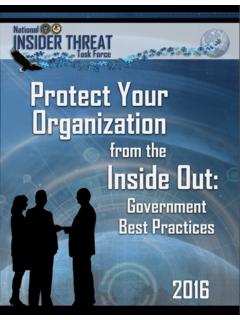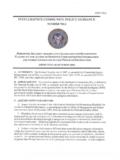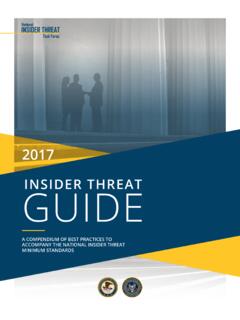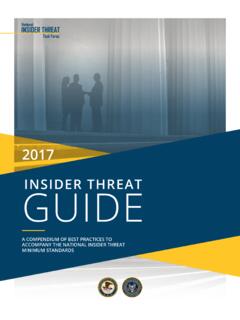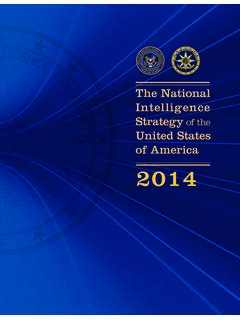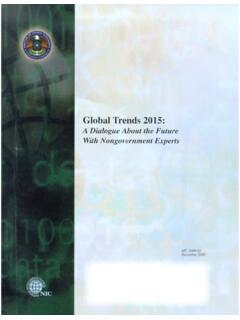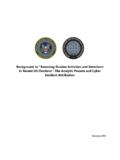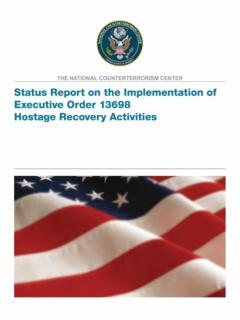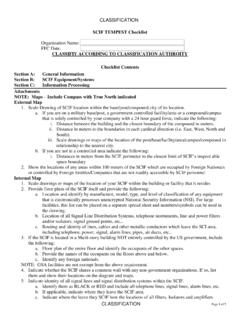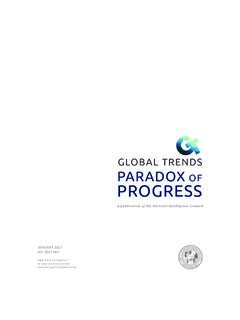Transcription of Table of Contents - dni.gov
1 Iii1 Table of ContentsTab 1: InTellIgence OvervIewDefining and Using Intelligence ..7 What is the Intelligence Community? ..7 The Six Steps in the Intelligence Cycle ..10 Tab 2: InTellIgence cOmmunITy membersOffice of the Director of National Intelligence ..15 Central Intelligence Agency ..18 Defense Intelligence Agency ..20 National Geospatial-Intelligence Reconnaissance Office ..23 National Security Agency ..23 Department of Energy, Office of Intelligence and Counterintelligence ..25 Department of Homeland Security, Office of Intelligence and Analysis ..25 Coast Guard ..27 Department of Justice, Drug Enforcement Administration ..27 Department of Justice, Federal Bureau of Investigation ..29 Department of State, Bureau of Intelligence and Research.
2 31 Department of the Treasury, Office of Intelligence and Analysis ..32 Army ..32 Navy ..33 Air Force ..34 Marine Corps ..34 Tab 3: requIremenTs, PlannIng, and dIrecTIOnWhat Intelligence Can (and Cannot) Do ..39 Who Uses Intelligence? ..412 Intelligence Planning, Programming, Budgeting and Evaluation ..44 Acquisition/Science and Technology: Delivering Technical Capabilities ..45 Intelligence Community Requirements Processes ..46 Collection Management Overview ..47 Prioritizing Intelligence Issues: The National Intelligence Priorities Framework ..49 Tab 4: cOllecTIOn, PrOcessIng, and exPlOITaTIOnSources of Intelligence ..53 GEOINT ..53 HUMINT ..54 SIGINT ..55 Processing and Exploitation ..56 Tab 5: analysIs, PrOducTIOn, and FeedbackAnalysis and Production.
3 59 Estimative Language ..59 Analytic Products ..60 Classification ..61 Review and Release ..62 Tab 6: OrganIzaTIOnal OversIghTJoint Intelligence Community Council ..67 Legislative Oversight ..68 National Security Council ..69 President s Intelligence Advisory Board ..70 Office of the Inspector General ..70 Financial Management and Oversight ..70 Equal Employment Opportunity and Diversity ..71 Civil Liberties and Privacy Office ..723 Tab 7: careers In The InTellIgence cOmmunITyThe Benefits of Working in the IC ..75 Tab 8: reFerencesGlossary of and Abbreviations ..86 Resources ..90 Laws and Policies Governing the IC ..94 Subject Index ..9745 IntelligenceOverviewINTELLIGENCEOVERVIEW In the early morning hours of May 2, 2011, a military raid on an al-Qa ida compound in Abbot-tabad, Pakistan, killed America s most-wanted terrorist, Usama Bin agencies and partners across the Intelligence Community had been collecting intelligence about the compound since it was discovered in August 2010.
4 The raid on the compound, authorized by the President on April 29, was conducted by a small team of special operations soldiers. The raid was designed to minimize collateral damage and risk to non-combatants in the compound and Pakistani civilians in the death of Bin Ladin, al-Qa ida s founder and only amir, or commander, in its 22-year history, marks the single greatest victory in the campaign to disrupt, dismantle, and eventually dissolve al-Qa ida. THE OPERATION THAT KILLED BIN LADINC ourtesy of CIA7 IntelligenceOverviewDefining and Using IntelligenceAccording to the Intelligence Reform and Ter-rorism Prevention Act of 2004 (IRTPA), the terms National Intelligence and intelligence related to national security refer to all intel-ligence, regardless of the source from which it is derived and including information gathered within or outside the United States, n that pertains, as determined to be con-sistent with any guidance issued by the President, to more than one Govern-ment agency; and n that involves:n Threats to the , its people, property, or interests;n The development, proliferation, or use of weapons of mass destruction.
5 Orn Any other matter bearing on national homeland Government uses intelligence to improve and more fully understand the con-sequences of its national security decisions. Intelligence informs policy decisions, military actions, international negotiations, and inter-actions with working-level contacts in foreign countries. In some circumstances, intelligence can also aid the efforts of homeland security providers and first is the Intelligence Community?The Intelligence Community (IC) is a group of Executive Branch agencies and organizations that work separately and together to engage in intelligence activities that are necessary for the conduct of foreign relations and the protection of the national security of the United activities include.
6 N Collection of information needed by the President, the National Security Council, 8the Secretaries of State and Defense, and other Executive Branch officials for the performance of their duties and fulfillment of their Production and dissemination of Collection of information concerning intelligence activities directed against the United States, international terrorist and narcotics activities, and other such hostile activities carried out by foreign powers, organizations, persons, and their The conduct of actions to protect against hostile activities directed against the United States. n Performance of special Performance of administrative and support activities within the United States and abroad that are necessary for the performance of various other intelligence Performance of such other intelligence activities as the President may direct from time to IC is led by the Director of National Intel-ligence (DNI), who is the head of the Office of the Director of National Intelligence (ODNI) and whose duty is to coordinate the other 16 IC components based on intelligence consumers needs.
7 The other members of the IC are divided into three groups: Program Managers, Depart-ments, and Service Program Managers advise and assist the ODNI in identifying collection requirements, developing budgets, managing finances, and evaluating the IC s performance. n Departments are IC components embed-ded within Government departments (other than the Department of Defense [DoD]). These components focus on serving their parent department s intelligence All intelligence personnel in the armed forces are members of the Service IC components, which primarily support their own Service s information needs. Each Service has at least one major intelligence organization as well as intelligence officers integrated throughout its IntegrationThe core mission of ODNI is to lead the Intel-ligence Community in intelligence integra-tion.
8 Basically, intelligence integration means synchronizing collection, analysis, and counter-intelligence so that they are fused effectively operating as one Intelligence Strategies (UIS) are the central critical plans for achieving intel-ligence integration. They cover our strategies by geography and topic. They foster an environ-ment that encourages, enables, and recognizes integration at all levels of the ForceIntelligenceArmyIntelligenceCoast GuardIntelligenceMarine CorpsIntelligenceNavalIntelligenceOFFICE OF THE DIRECTOR OF THE NATIONAL INTELLIGENCESERVICESC entral Intelligence AgencyDefenseIntelligenceAgencyFBIN ationalSecurityBranchNationalGeospatial- IntelligenceAgencyNationalReconnaissance Of ceNationalSecurityAgencyPROGRAM MANAGERSDEA Of ceof NationalSecurity IntelligenceEnergy Of ce ofIntelligence andCounter-IntelligenceDHS Of ce ofIntelligenceand AnalysisState Bureau of Intelligenceand ResearchTreasury Of ceof Intelligenceand AnalysisDEPARTMENTSN ational Intelligence Managers (NIMs)
9 And their teams create UIS in line with the IC prioritized requirements. They are thus charged with leading integration across the IC by topic and region. 10 Planning & DirectioncollectionProcessing & exPloitation analysis & ProDuctionDisseminationevaluationThe Six Steps in the Intelligence CycleThe Intelligence Cycle is the process of devel-oping raw information into finished intelligence for use by policymakers, military commanders, and other consumers in decisionmaking. This six- step cyclical process is highly dynamic, continuous, and never-ending . The sixth step , evaluation (which includes soliciting feedback from users) is conducted for each of the other five steps individually and for the Intelligence Cycle as a whole.
10 The six steps that constitute the Intelligence Cycle are as follows: 11 PlannIng and dIrecTIOn: establish the consumer s intel-ligence requirements and plan intelligence activities accordingly. The planning and direction step sets the stage for the Intel-ligence Cycle. It is the spring-board from which all Intelligence Cycle activities are launched. Oftentimes, the direction part of the step precedes the planning part. Generally, in such cases, the consumer has a require-ment for a specific product. That product may be a full report, a graphic image, or raw informa-tion that is collected, processed, and disseminated, but skips the analysis and production step . Given the customer s require-ment, the intelligence organiza-tion tasked with generating the product will then plan its Intel-ligence Cycle activities.
